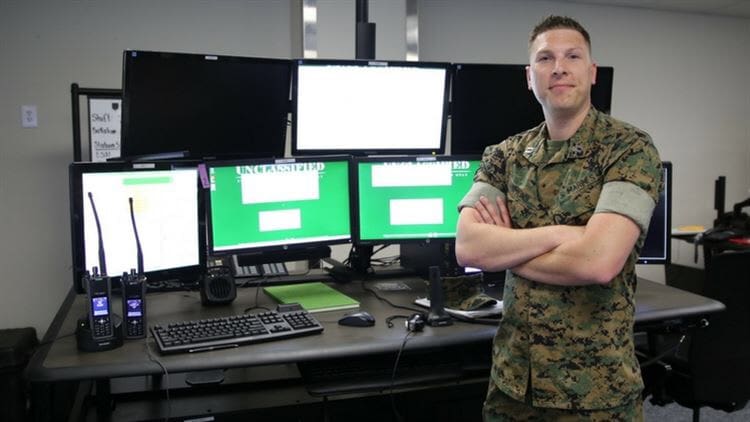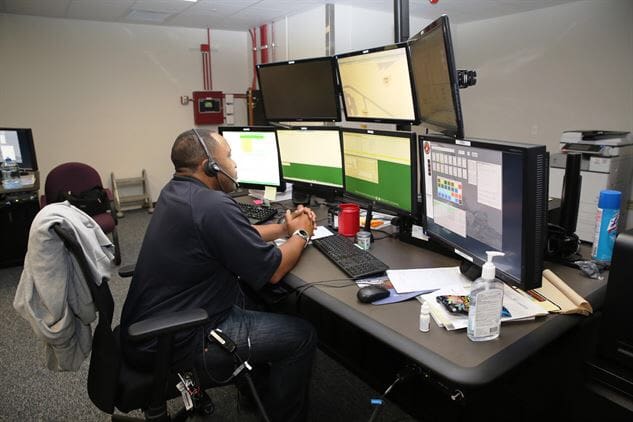MARINE CORPS BASE QUANTICO, Va. —
Marine Corps bases worldwide are gaining increased emergency response capabilities with the implementation of the Consolidated Emergency Response System, or CERS. CERS standardizes emergency dispatching capabilities and provides emergency first responders with enhanced command and coordination to support all hazardous response missions aboard Marine Corps installations.

Maj. Mark Simmons, systems engineer for Consolidated Emergency Response System, stands in front of a newly-installed CERS emergency dispatcher workstation aboard Marine Corps Base Quantico, Va. CERS aggregates multiple capabilities—Enhanced 911, Computer-Aided Dispatch, and fire station alerting—into a single workstation, giving emergency dispatchers the ability to quickly dispatch the appropriate assets where necessary. CERS increases the effectiveness of emergency response operations aboard Marine Corps installations worldwide. (U.S. Marine Corps photo by Ashley Calingo)
CERS was conceived following the 2009 Fort Hood shooting in which 13 people were killed and 43 wounded or injured. A Department of Defense review of the tragedy highlighted opportunities for improved emergency response procedures and capabilities throughout the DoD. In response, the Marine Corps created the CERS program of record, a multifaceted system that integrates modernized equipment and software to expedite and streamline emergency response activities.
“The Consolidated Emergency Response System standardizes and modernizes emergency dispatching capabilities across the Marine Corps,” said Maj. Mark Simmons, systems engineer for CERS and Enhanced 911 at Marine Corps Systems Command. “CERS aggregates multiple capabilities—E911, Computer-Aided Dispatch, incident records management and fire station alerting—into a single workstation, giving emergency dispatchers the ability to quickly, and more accurately, dispatch the appropriate assets where necessary in the shortest time possible.”
Modernized Capabilities
CERS was implemented in two phases. The first implementation phase involved the installation of the E911 system on Marine Corps bases worldwide beginning in 2014. E911 provides enhanced, GPS coordinate-driven caller location information to emergency dispatchers, enabling them to provide more precise location information to emergency responders. E911 also establishes 911 as the only number to call for emergencies aboard Marine Corps bases.
“Previously, a lot of bases had a standard base telephone number that they’d call for emergency, fire, law enforcement or emergency medical services, instead of simply dialing 911,” said Simmons. “Now, emergency calls are routed to a single place. Anytime there’s an emergency on base, dial 911.”
The second phase of CERS involved the installation of Computer-Aided Dispatch, incident records management and fire station alerting capabilities.
Computer-Aided Dispatch, or CAD, is the second major component of CERS. CAD is a computer application that allows dispatchers to accurately track and task available emergency responders to expedite response times.
“Essentially, CAD is going to help emergency dispatchers get the first responders to the incident in the quickest, most efficient manner,” said George Berger, Emergency Dispatch Services program manager at Marine Corps Installation Command. “CAD provides an incident records management system and will help emergency dispatchers provide resource management situational awareness.”

An emergency dispatcher uses the newly-installed Consolidated Emergency Response System emergency dispatcher workstation aboard Marine Corps Base Quantico, Va. CERS aggregates multiple capabilities—Enhanced 911, Computer-Aided Dispatch, and fire station alerting—into a single workstation, giving emergency dispatchers the ability to quickly dispatch the appropriate assets where necessary. CERS increases the effectiveness of emergency response operations aboard Marine Corps installations worldwide. (U.S. Marine Corps photo by Ashley Calingo)
The incident records management system enables dispatch center supervisors to easily retrieve data from past emergency events. Before the incident records management system, supervisors had to review logbooks and databases from different emergency response groups—such as law enforcement and fire—in order to collect all the details that occurred during an incident. Now, the supervisor may accomplish the research from their workstation, using a dedicated organized process not previously available, said Berger.
Enhanced fire station alerts streamline dispatchers’ ability to send emergency responders to the scene of an incident. Base fire stations are also outfitted with upgraded audio and visual cues that are deployable at the push of a dispatcher’s button, decreasing the time it takes for dispatchers to alert emergency responders.
Together, the systems in CERS match the capabilities found in civilian emergency dispatch centers, increasing the effectiveness of operations and lowering response time to incidents aboard Marine Corps installations.
Impacting Marine installations worldwide
The Marine Requirements Oversight Council selected 13 of the 24 Marine Corps bases worldwide to receive CERS. Currently, phase two of CERS is being implemented in emergency dispatch centers at the 13 selected installations. Before CERS, each base had its own method of emergency dispatching, said Berger.
“In many cases, the older emergency dispatch system may have consisted of a pen and paper,” said Berger. “CERS is a standardized solution, which will help coordinate all calls for service and support the moving parts of law enforcement, fire and emergency medical service activities.”
CERS is part of the Supporting Establishment Systems portfolio at Marine Corps Systems Command. The CERS team provides critical information technology solutions to emergency first responders at Marine Corps installations worldwide, heightening the safety and security of Marines, sailors, civilians and families who live and work on base.
“I want to say thank you to the Marine Corps Systems Command folks for going through this effort and fielding this solution,” said Berger. “It’s been a long time coming and the team has been working hard. As the headquarters advocate, I truly appreciate their efforts, as do each of the 13 Installations.”
By Ashley Calingo, MCSC Office of Public Affairs and Communication | Marine Corps Systems Command | June 13, 2017


I hope the Army is spending taxpayer money on a totally different system of their own.
I like it. Go Harris.
That’s all well and good but I sure like to think they aren’t dumb enough to install just one workstation per installation.
I mean computers never break, buildings never flood or catch fire, bad guys never look for single points of failure to exploit, and all that.
However, after 4 years in the Corps and twenty years in the IT world I wouldn’t take the bet that they’re that smart.